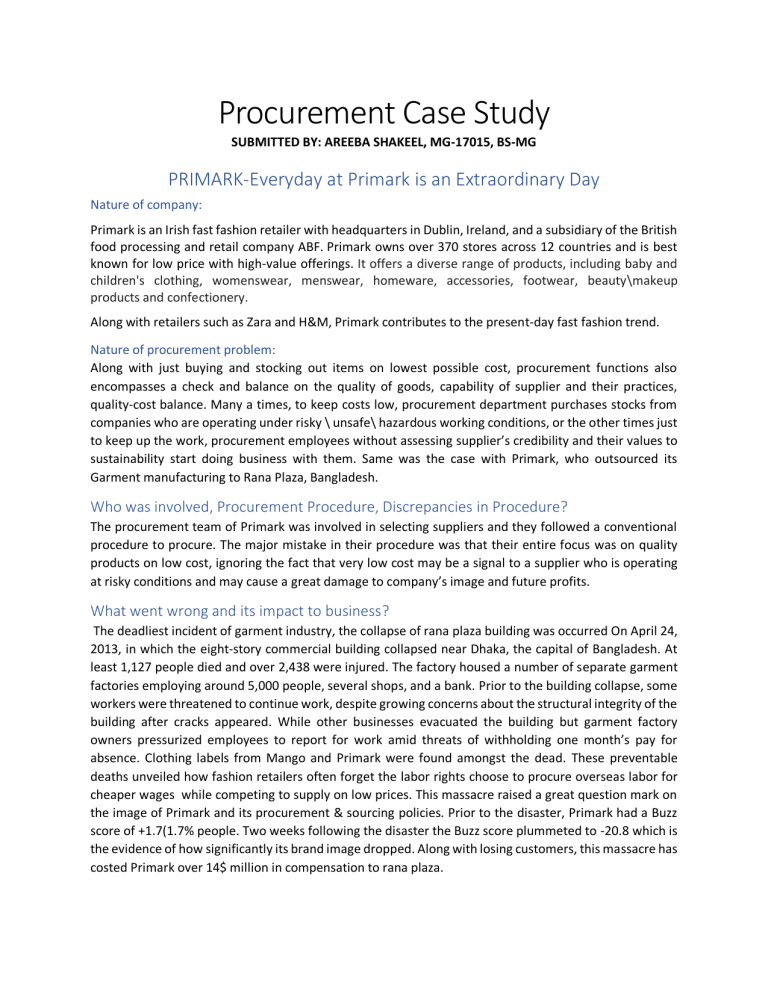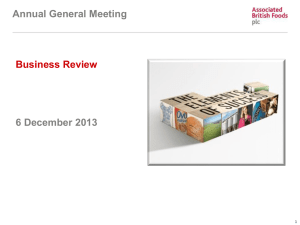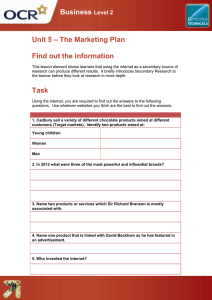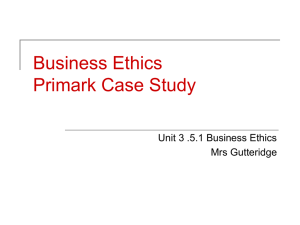
Procurement Case Study SUBMITTED BY: AREEBA SHAKEEL, MG-17015, BS-MG PRIMARK-Everyday at Primark is an Extraordinary Day Nature of company: Primark is an Irish fast fashion retailer with headquarters in Dublin, Ireland, and a subsidiary of the British food processing and retail company ABF. Primark owns over 370 stores across 12 countries and is best known for low price with high-value offerings. It offers a diverse range of products, including baby and children's clothing, womenswear, menswear, homeware, accessories, footwear, beauty\makeup products and confectionery. Along with retailers such as Zara and H&M, Primark contributes to the present-day fast fashion trend. Nature of procurement problem: Along with just buying and stocking out items on lowest possible cost, procurement functions also encompasses a check and balance on the quality of goods, capability of supplier and their practices, quality-cost balance. Many a times, to keep costs low, procurement department purchases stocks from companies who are operating under risky \ unsafe\ hazardous working conditions, or the other times just to keep up the work, procurement employees without assessing supplier’s credibility and their values to sustainability start doing business with them. Same was the case with Primark, who outsourced its Garment manufacturing to Rana Plaza, Bangladesh. Who was involved, Procurement Procedure, Discrepancies in Procedure? The procurement team of Primark was involved in selecting suppliers and they followed a conventional procedure to procure. The major mistake in their procedure was that their entire focus was on quality products on low cost, ignoring the fact that very low cost may be a signal to a supplier who is operating at risky conditions and may cause a great damage to company’s image and future profits. What went wrong and its impact to business? The deadliest incident of garment industry, the collapse of rana plaza building was occurred On April 24, 2013, in which the eight-story commercial building collapsed near Dhaka, the capital of Bangladesh. At least 1,127 people died and over 2,438 were injured. The factory housed a number of separate garment factories employing around 5,000 people, several shops, and a bank. Prior to the building collapse, some workers were threatened to continue work, despite growing concerns about the structural integrity of the building after cracks appeared. While other businesses evacuated the building but garment factory owners pressurized employees to report for work amid threats of withholding one month’s pay for absence. Clothing labels from Mango and Primark were found amongst the dead. These preventable deaths unveiled how fashion retailers often forget the labor rights choose to procure overseas labor for cheaper wages while competing to supply on low prices. This massacre raised a great question mark on the image of Primark and its procurement & sourcing policies. Prior to the disaster, Primark had a Buzz score of +1.7(1.7% people. Two weeks following the disaster the Buzz score plummeted to -20.8 which is the evidence of how significantly its brand image dropped. Along with losing customers, this massacre has costed Primark over 14$ million in compensation to rana plaza. What Primark has done for this? Initially the response of Primark was mixed. Their image dropped down further, when it was revealed that the inadequate compensation of $200, they offered to families of the deceased could only be claimed if DNA evidence of their relative’s death could be supplied. Unsurprisingly, this inhumane approach further added to the loss of Primark. However, after this, Primark signed the Bangladesh Accord within 2 months of the disaster This agreement legally bonded to build safe and fair working conditions for Bangladeshi workers, has been universally praised as transformative and a key incentive for suppliers to raise their ethical standards. The terms mandated independent auditing programs, public disclosure of all inspection reports, implementation of democratically-elected health and safety committees in all factories, and empowering workers through a complaints mechanism and the right to refuse unsafe work. Furthermore, Primark developed its own Code of Conduct for suppliers to adhere to. In direct response to the Rana Plaza disaster, civil engineers are now an integral part of Primark’s Ethical Trade team. They are routinely utilized to assess the structural integrity of factory buildings to maintain health and safety standards. Primark has reformed its auditing process of supplier factories. During this process, confidential worker interviews are undertaken to provide an authentic perspective on labor conditions, especially where supervisors create artificial environments to hide abuses. All supplier factories are audited prior to production to certify they meet the standards set out by the Code of Conduct. Primark have facilitated an open dialogue with workers through their Drawing the Line (DTL) initiative What would be done alternatively (retrospective)? This Massacre wouldn’t have happened in the first place if the procurement team assessed suppliers before making the contract. furthermore, it is the job of procurement department to maintain close relationship with their 1st tier suppliers. Primark could have saved billions of dollars if its procurement team had been doing, even half of this before the collapse what it is doing right now. What would you do if you had been procurement manager? If I would have been the procurement manager, this incompetency in selecting suppliers wouldn’t have happened in the first place. I would’ve maintained well check and balance on my suppliers especially to the first tiers one. Still, if such incident had happened in my term, I would have taken action immediately for compensating the loss of lives and what they have done later, so that my brand repute could be saved instead of asking for DNA evidence.




